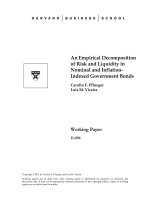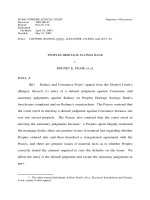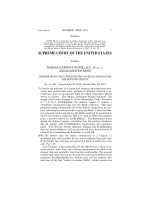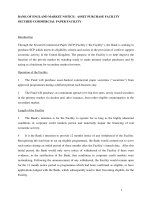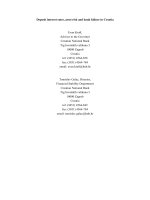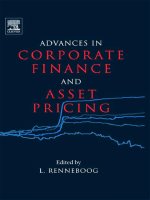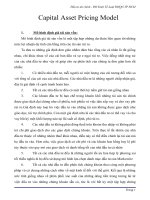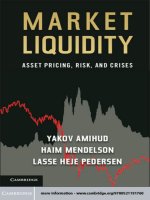amihud et al - market liquidity; asset pricing, risk, and crises (2013)
Bạn đang xem bản rút gọn của tài liệu. Xem và tải ngay bản đầy đủ của tài liệu tại đây (1.37 MB, 293 trang )
MARKET LIQUIDITY
This book presents the theory and evidence on the effect of market liquidity
and liquidity risk on asset prices and on overall securities market performance.
Illiquidity means incurring high transaction cost, which includes a large price
impact when trading and facing a long time to unload a large position. Liquidity
risk is higher if a security becomes more illiquid when it needs to be traded in the
future, which will raise its trading cost. The analysis in this book shows that higher
illiquidity and greater liquidity risk reduce securities prices and raise the expected
return that investors require as compensation. Aggregate market liquidity is linked
to funding liquidity, which affects the provision of liquidity services. When these
become constrained, there is a liquidity crisis, which leads to downward price and
liquidity spiral. Overall, this book demonstrates the important role of liquidity in
asset pricing.
Yakov Amihud is the Ira Rennert Professor of Finance at the Stern School of
Business, New York University. His research focuses on the effects of the liquidity
of stocks and bonds on their returns and values, and the design and evaluation
of securities markets’ trading methods and systems. On these topics, Professor
Amihud has advised the New York Stock Exchange, American Stock Exchange,
Chicago Board of Options Exchange, Chicago Board of Trade, and other securities
markets. He has published more than ninety research articles on economics and
finance in professional journals and in books, and has edited and co-edited five
books on securities market design, international finance, leveraged buyouts, and
bank mergers and acquisitions.
Haim Mendelson is the Kleiner Perkins Caufield & Byers Professor of Electronic
Business and Commerce, and Management, at the Graduate School of Business,
Stanford University. His research interests include securities markets, electronic
markets, information technology, and the information industries. He was elected
Distinguished Fellow of the Information Systems Society in recognition of outstanding intellectual contributions to the discipline. Professor Mendelson has
published more than one hundred research papers in professional journals and
has consulted for high-tech companies, financial institutions, and securities markets including the New York Stock Exchange, American Stock Exchange, Chicago
Board of Options Exchange, and Chicago Board of Trade.
Lasse Heje Pedersen is the John A. Paulson Professor of Finance and Alternative
Investments at the Stern School of Business, NYU, and a principal at AQR Capital
Management. He has been part of the Liquidity Working Group of the Federal
Reserve Bank of New York, the New York Fed’s Monetary Policy Panel, the Board of
Directors of the American Finance Association, the Economic Advisory Boards of
NASDAQ and FTSE, and associate editor at the Journal of Finance, Journal of Economic Theory, Review of Asset Pricing Studies, and Quarterly Journal of Economics.
His research explains how crises can arise from liquidity spirals and how market
and funding liquidity risks explain equity returns, bond yields, option prices, and
currency crashes. Professor Pedersen received the 2011 Bern` cer Prize to the best
a
European Union economist under 40 years of age.
Market Liquidity
Asset Pricing, Risk, and Crises
YAKOV AMIHUD
Stern School of Business, New York University
HAIM MENDELSON
Graduate School of Business, Stanford University
LASSE HEJE PEDERSEN
Stern School of Business, New York University
cambridge university press
Cambridge, New York, Melbourne, Madrid, Cape Town,
Singapore, S˜o Paulo, Delhi, Mexico City
a
Cambridge University Press
32 Avenue of the Americas, New York, NY 10013-2473, USA
www.cambridge.org
Information on this title: www.cambridge.org/9780521139656
C
Yakov Amihud, Haim Mendelson, and Lasse Heje Pedersen 2013
This publication is in copyright. Subject to statutory exception
and to the provisions of relevant collective licensing agreements,
no reproduction of any part may take place without the written
permission of Cambridge University Press.
First published 2013
Printed in the United States of America
A catalog record for this publication is available from the British Library.
Library of Congress Cataloging in Publication Data
Market liquidity : asset pricing, risk, and crises / Yakov Amihud, Stern School of Business,
New York University, Haim Mendelson, Graduate School of Business, Stanford University,
Lasse Heje Pedersen, Stern School of Business, New York University.
pages cm
Includes bibliographical references and index.
ISBN 978-0-521-19176-0 (hardback) – ISBN 978-0-521-13965-6 (paperback)
1. Liquidity (Economics) 2. Securities – Prices. I. Amihud, Yakov, 1947–
II. Mendelson, Haim. III. Pedersen, Lasse Heje.
HG178.M37 2013
332.63 222–dc23
2012010868
ISBN 978-0-521-19176-0 Hardback
ISBN 978-0-521-13965-6 Paperback
Cambridge University Press has no responsibility for the persistence or accuracy of URLs for
external or third-party Internet Web sites referred to in this publication and does not guarantee
that any content on such Web sites is, or will remain, accurate or appropriate.
Contents
Acknowledgments
page vii
Introduction and Overview of the Book
ix
PART I. THE EFFECT OF LIQUIDITY COSTS ON SECURITIES
PRICES AND RETURNS
Introduction and Overview
1
1
Asset Pricing and the Bid–Ask Spread
Summary and Implications
Article by Yakov Amihud and Haim Mendelson
2
Liquidity, Maturity, and the Yields on U.S. Treasury Securities
Summary and Implications
Article by Yakov Amihud and Haim Mendelson
3
9
18
47
52
Market Microstructure and Securities Values: Evidence from the
Tel Aviv Stock Exchange
Summary and Implications
Article by Yakov Amihud, Haim Mendelson, and Beni Lauterbach
69
72
PART II. LIQUIDITY RISK
Introduction and Overview
4
101
Illiquidity and Stock Returns: Cross-Section and Time-Series
Effects
105
110
Summary and Implications
Article by Yakov Amihud
5
Asset Pricing with Liquidity Risk
Summary and Implications
Article by Viral V. Acharya and Lasse Heje Pedersen
v
137
143
vi
Contents
PART III. LIQUIDITY CRISES
Introduction and Overview
6
Market Liquidity and Funding Liquidity
Summary and Implications
Article by Markus K. Brunnermeier and Lasse Heje Pedersen
7
196
199
Liquidity and the 1987 Stock Market Crash
Summary and Implications
Article by Yakov Amihud, Haim Mendelson, and Robert Wood
8
185
245
248
Slow Moving Capital
Summary and Implications
Article by Mark Mitchell, Lasse Heje Pedersen, and Todd Pulvino
258
260
References for Introductions and Summaries
271
Index
275
Acknowledgments
Acknowledgment is gratefully made to the following co-authors and journals for their permission to reprint the original articles included here:
Yakov Amihud and Haim Mendelson, Asset pricing and the bid–ask
spread. Journal of Financial Economics 17, 1986
Yakov Amihud and Haim Mendelson, Liquidity, maturity and the yields
on U.S. Treasury securities. Journal of Financial Economics 46, 1991
Yakov Amihud, Haim Mendelson, and Beni Lauterbach, Market microstructure and securities values: Evidence from the Tel Aviv Stock
Exchange. Journal of Financial Economics 45, 1997
Yakov Amihud, Illiquidity and stock returns: Cross-section and timeseries effects. Journal of Financial Markets 5, 2002
Viral V. Acharya and Lasse Heje Pedersen, Asset pricing with liquidity
risk. Journal of Financial Economics 77, 2005
Markus K. Brunnermeier and Lasse Heje Pedersen, Market liquidity and
funding liquidity. Review of Financial Studies 22, 2009
Yakov Amihud, Haim Mendelson, and Robert Wood, Liquidity and the
1987 stock market crash. Journal of Portfolio Management 16, 1990
Mark Mitchell, Lasse Heje Pedersen, and Todd Pulvino, Slow moving
capital. American Economic Review 97, 2007
vii
Introduction and Overview
of the Book
This book is about the pricing of liquidity. We present theory and evidence
on how liquidity affects securities prices, why liquidity varies over time,
how a drop in liquidity leads to a decline in prices, and why liquidity
crises create liquidity spirals. The analysis has important implications for
traders, risk managers, central bankers, performance evaluation, economic
policy, regulation of financial markets, management of liquidity crises, and
academic research.
Liquidity and its converse, illiquidity, are elusive concepts: You know it
when you see it, but it is hard to define. A liquid security is characterized
by the ability to buy or sell large amounts of it at low cost. A good example
is U.S. Treasury bills, which can be sold in blocks of $20 million dollars
instantaneously at the cost of a fraction of a basis point. On the other
hand, trading an illiquid security is difficult, time-consuming, and/or costly.
Illiquidity is observed when there is a large difference between the offered
sale price and the bid (buying) price, if trading of a large quantity of a
security moves its price by a lot, or when it takes a long time to unload a
position. A recent example of this is collateralized debt obligations, which
investment banks have not been able to unload at an acceptable price for a
long time.
Liquidity risk is the risk that a security will be more illiquid when its
owner needs to sell it in the future, and a liquidity crisis is a time when many
securities become highly illiquid at the same time. Some liquidity crises are
dramatic: investors have a hard time selling the equities they want when
prices fall as they submit their sale orders; market makers who are supposed
to provide liquidity take their phones off the hook; or currency traders say
it will take twenty days to trade out of large positions instead of the usual
two days.
ix
x
Introduction and Overview of the Book
Historically, financial economists used to ignore liquidity problems: The
theory assumed “frictionless markets,” which are perfectly liquid all of the
time, and most academics considered this assumption to be innocuous. We
believe otherwise. In this book, we argue that illiquidity is a central feature of
the securities and financial markets. We present and review central research
contributions on liquidity and its effect on asset prices made over the
past twenty-five years. Recent events have borne out our thesis: the Global
Financial Crisis of 2007–2009 illustrates all too dramatically the importance
of liquidity and liquidity risk and their effects on securities prices and on
the functioning of financial markets.
The recent crisis is just one of a series of liquidity crises in the history of
finance. Traders, regulators, and other market participants have long recognized the central importance of liquidity in financial markets. Securities
market regulations aim to enhance the liquidity of the markets as a central
goal, and market practitioners know that the cost and time of implementing
trades are important determinants of performance. Sophisticated financial
institutions are already implementing some of the techniques presented in
this book in their trading and pricing models, and their ability to manage
liquidity risk in addition to market risk make the difference between success
and failure, as pointed out by the Chairman of the Federal Reserve, Ben
Bernanke:
Some more-successful firms also consistently embedded market liquidity premiums
in their pricing models and valuations. In contrast, less-successful firms did not
develop adequate capacity to conduct independent valuations and did not take into
account the greater liquidity risks posed by some classes of assets.1
Each of this book’s three parts addresses a different facet of friction in
financial markets: liquidity, liquidity risk, and liquidity crises. Each part
starts with a brief overview that explains the theory and how to apply it, and
the evidence that supports it. Each part then presents original articles in
that research area and, for each article, gives a short summary of its essential
ideas, findings, and later extensions.
Part I introduces the theory of why liquidity is priced and focuses on the
effect of the level of liquidity on securities’ required returns. Across securities, investors are willing to pay lower prices, or demand higher returns, for
securities that are more costly to trade. This gives rise to a positive relation
between securities’ trading costs and expected returns, or a negative relation
1
Bernanke at the Chicago Federal Reserve Annual Conference on Bank Structure and
Competition, Chicago, Illinois, May 15, 2008.
Introduction and Overview of the Book
xi
between trading costs and prices (for any given cash flow that the security
generates). As the liquidity of securities rises, so does their price.
Part II shows that over time, market liquidity shocks translate into shocks
in market prices and vice versa. A rise in market illiquidity, which means
a greater cost of trading, makes forward-looking investors require higher
future yields on their investments for any given cash flows generated by
these investments because they expect the illiquidity to persist for a while.
This increase in the required return causes securities’ prices to fall. The
result is a negative relation between market illiquidity changes and changes
in market price levels. Therefore, the effect of market liquidity shocks on
securities market prices introduces additional risk to market returns beyond
the risk that is associated with shocks to expectations about future cash
flows.
Faced with the risk of such liquidity and price shocks, risk-averse investors
prefer securities whose returns and trading costs are less sensitive to marketwide liquidity shocks and whose trading costs do not rise when market prices
fall. In short, investors prefer securities with lower liquidity risk. The higher
the liquidity risk, the higher the expected return required as compensation.
Part III discusses how liquidity crises arise as shocks are amplified manyfold through liquidity spirals. It describes how liquidity dries up when its
providers – dealers, proprietary traders, and hedge funds – run out of capital
and need to reduce their positions. A crash in market prices imposes greater
constraints on the traders’ resources (i.e., reduces their funding liquidity),
and consequently traders are less able to provide liquidity to the market. As
the ability to fund trading activity declines, so does market liquidity. This
generates a vicious cycle that creates liquidity crises: a reduction in market
liquidity pushes prices down and worsens the funding problems, which, in
turn, reduces market liquidity and increases volatility as market conditions
spiral downward.
The liquidity paradigm presented in this book should be viewed in
contrast to the traditional economic paradigm. The traditional paradigm
assumes that investors are able to trade without transaction costs (frictionless markets), asset prices depend only on their fundamentals (the Law
of One Price), corporations’ investment decisions are independent of how
they finance themselves (the Modigliani-Miller proposition), and derivative
prices can be determined using no-arbitrage pricing.
During the recent global financial crisis, these basic pillars of traditional
finance and economics were fundamentally shaken as the importance of
liquidity risk became more apparent than ever: The Law of One Price broke
down in currency markets (the covered interest rate parity failed), credit
xii
Introduction and Overview of the Book
markets (a price gap opened between corporate bonds and credit default
swaps), and other markets (documented by Garleanu and Pedersen 2011).
Corporations strapped for cash felt the tightening of liquidity and had to
change their investment policy, violating the Modigliani-Miller proposition
(Ivashina and Scharfstein 2010). Funding problems in the financial sector
and broader liquidity deterioration sent the economy into a severe recession,
showing how financial liquidity shocks can affect the business cycle beyond
the effect of real economic factors. Central banks scrambled to introduce
unconventional forms of monetary policy to improve market and funding
liquidity, such as the purchasing of bonds and liquidity facilities targeted at
alleviating investors’ funding frictions and margin requirements (Ashcraft,
Garleanu, and Pedersen 2010).
Paradoxically, not only did financial frictions increase dramatically during the crisis, but policy makers attempted to improve the situation by
introducing additional frictions such as short sale bans and transaction
taxes, although such initiatives are not supported by the theory presented
in this book.
Having seen how liquidity and transaction costs affect asset prices, what
can finance professionals glean from the insights presented in this book?
Portfolio managers can incorporate liquidity considerations into portfolio construction and management strategies. These strategies should consider the portfolio’s current liquidity characteristics and its liquidity risk,
just as they incorporate standard market risk into the analysis. The results
reported in this book provide a rigorous approach that can be employed
in both thinking about portfolio composition and implementing portfolio
strategies through trades.
Traders in financial markets are probably aware of the importance of
transaction costs. This book provides a structured approach for quantifying
their effect and thinking about the implementation of trading strategies that
take liquidity cost considerations into account. Strategies that produce paper
profits may fail in implementation because liquidity costs offset potential
gains that could have been earned had it been feasible to execute trades
at observed market prices. Therefore, traders should perform an analysis
of their own transaction costs, either in-house or through a professional
transaction cost analysis provider.
The effect of liquidity on prices also presents opportunities for investors.
Investors with long horizons or superior trading technology can earn the
liquidity premium by buying illiquid securities. Further, since the liquidity
premium varies over time, the returns to buying illiquid securities are
Introduction and Overview of the Book
xiii
expected to be the highest after times of crises when capital pursuing such
strategies is scarce.
Corporate financial managers should not take the liquidity of their company’s publicly traded claims – stocks and bonds – as exogenously given.
They can employ corporate policies that enhance the liquidity of their company’s claims.2 The evidence presented in this book shows that such policies
can reduce the corporate cost of capital and raise the company’s market
value. Liquidity-enhancing policies include greater transparency and better information disclosure practices that reduce informational asymmetry
and thus improve liquidity. Liquidity also increases when the company’s
investor base is broadened and there is greater dispersion of ownership
among investors who are likely to trade the stock. Means to achieve that
include improved investor relations, advertising, and facilitating trades in
small stock units. Multiple types of securities lead to fragmentation of the
company’s investor base, which can reduce liquidity and value. Therefore,
having fewer types of claims, each with a larger float, contributes to greater
liquidity. Capital structure and leverage policies may also affect liquidity to
the extent that they affect the liquidity of the company’s stocks and bonds.
Also, when deciding to distribute cash to shareholders, stock buybacks may
be preferred only if they do not hamper stock liquidity.
Policy makers and regulators should incorporate liquidity considerations
into policy decisions on financial markets. For example, regulations that
increase disclosure and reduce information asymmetry – such as Regulation
Fair Disclosure and mandating the prompt release of pertinent information,
as well as the prohibition of insider trading – contribute to increase market
liquidity. Major market reforms, such as the reduction in the minimum
tick (price change) from $1/8 to $1/16 and finally to $0.01 reduced the
cost of trading for many stocks, especially the frequently traded stocks that
constitute most of the value in the stock market. Also, while information
technology can be a double-edged sword, it can often increase liquidity and
reduce transaction costs: the dramatic increase in stock liquidity since the
1980s is no doubt due in large part to improvements in computing and
communications technologies.
The implications for public policy go beyond financial market structure
issues per se. For example, every few years, policy makers in the United
States and Europe propose to impose a securities transaction tax. As of the
2
An analysis of liquidity-enhancing corporate policies appears in Amihud and Mendelson
(1988, 2012).
xiv
Introduction and Overview of the Book
writing of this book, bills have been introduced in the U.S. Congress to place
a tax of up 0.25% on the value of stock trades (and a lower rate on other
financial instruments), and the European Commission has proposed a tax
of up to 0.10% on trading in stocks, bonds, and financial derivatives. Such
a tax naturally reduces market liquidity by increasing the cost of trading.
Eventually, investors will reduce their valuation of stocks by the present
value of the stream of taxes that they would have to pay. By the estimation
method presented in Chapter 1 to gauge the effect of transaction costs on
asset values, a tax of 0.25% on stock trading in the United States would
lead to a reduction of about 10% in the values of stocks. Put differently,
as Chapter 1 demonstrates, the tax will raise the required expected return
on investment in companies’ stocks. This means that the corporate cost
of capital will rise and the hurdle rate for new investments will be higher.
The result will be a reduction in real corporate investment. In this way, a
liquidity-reducing securities transaction tax will have negative effects on the
real economy.
Liquidity considerations also become important for central bankers during crises when financial stability is at risk, as Part III discusses. At such
times, central bankers often seek to improve the funding in the financial
system such that liquidity providers can continue to operate and market
liquidity is restored.
In summary, this book is about the effects of liquidity and liquidity risk
on financial markets. It presents and reviews central research in this area
and demonstrates how the liquidity theory provides a unified explanation
of asset price determination, market price dynamics, and severe market
breakdowns such as the recent global financial crisis. Liquidity problems
always lurk in the market, and this crisis highlights the importance of
liquidity and the price investors are willing to pay for it in dire economic
situations.
PART I
THE EFFECT OF LIQUIDITY
COSTS ON SECURITIES PRICES
AND RETURNS
Introduction and Overview
We begin by considering the direct effects of trading costs on the values of
financial assets. Investors require compensation for the trading costs they
pay when they buy or sell securities. If two assets generate the same cash
flows over time but one of them is less liquid (has higher trading costs),
rational investors will pay less for the less liquid asset, which costs more to
trade. Consequently, the less liquid asset will have a lower value and a higher
required (expected) return. Overall, we should observe that the returns on
financial assets are increasing in asset illiquidity or transaction costs. Just as
risk-averse investors require a higher return to compensate for a higher asset
risk, we propose that investors require a higher return to compensate for
greater asset illiquidity or transaction costs. The following chapters study
these relations.
First, we address the meaning of illiquidity or trading costs. Stated simply,
trading costs are the direct and indirect costs associated with trading a
security. The most easily measured component of trading costs is the direct
costs: brokerage fees, transaction taxes, and other trade-processing fees.
In addition, there are search and delay costs that arise because the buyers
and sellers of a security are not continuously available to transact, so a
seller needs to search for buyers, especially if he or she needs to liquidate a
large-size position and, similarly, a buyer needs to find sellers at the time
he or she wants to buy. Another component of trading costs is the bid–ask
spread. In securities markets with quoted bid and offer (ask) prices, which
are the buying and selling prices, the buy transaction is naturally executed
at a higher price than the sell transaction, resulting in a bid–ask spread.
However, the bid and ask prices apply only to limited trade quantities.
Larger transactions have a greater impact on the transaction price: They
1
2
The Effect of Liquidity Costs on Securities Prices and Returns
raise the buying price and lower the selling price, resulting in a market
impact cost. The market impact cost is greater for larger-size transactions,
when there is greater information asymmetry between the two parties in
the transaction, and when there is greater friction in accessing the market
by traders willing to trade.
The nature of trading costs depends on the structure of the market where
the security is traded. Most financial markets include market makers, intermediaries who buy or sell securities for their own accounts to close or narrow
down the time gaps between purchases and sales. These market makers may
be “official” market makers, such as the New York Stock Exchange (NYSE)
specialists or Nasdaq market makers, or they may be traders who submit
limit orders to the market and thus stand ready to buy and sell on demand.
Market makers are willing to take a long or short position in the security so
they will, for example, buy the security when a sell order arrives, hoping to
sell it shortly thereafter at a profit.1 As this happens, market makers accept
inventory risk for which they expect to be compensated. As their inventory position (short or long) increases, their risk further increases, which
means that the compensation they demand for each additional unit they
trade increases as well. Therefore, market makers quote bid and ask prices
at which they are willing to sell or buy limited quantities of the security,
but beyond that limited quantity they further increase the price at which
they are willing to sell or reduce the price at which they are willing to buy,
depending on the quantities involved.
This is further exacerbated by adverse selection, which results from the
fact that there is asymmetric information between traders about the value
of the asset being traded. Adverse selection arises when a trader sells a
security because he has private information that the security is overpriced.
An uninformed market maker or trader on the other side of the transaction
will try to protect himself by offering the seller a lower price. Similarly,
a purchase may indicate positive information that buyers have about the
security’s price, and this will induce uninformed market makers and traders
to ask for a higher selling price.2 The greater the extent of asymmetric
information, the lower will be the selling price and the higher will be
the buying price. Because uninformed sellers and buyers are viewed as
being possibly informed ones – other traders and market makers cannot
1
2
See Amihud and Mendelson (1980) for a formal model of market making. In the NYSE,
in addition to trading by market making, there was trading by auction. Amihud and
Mendelson (1987) analyze the effects of the two trading methods – auction and market
making – on stock return behavior. Mendelosn (1982) models securities price behavior in
an auction market.
See Glosten and Milgrom (1985) and Kyle (1985) for formal models.
The Effect of Liquidity Costs on Securities Prices and Returns
3
distinguish between informed and uninformed sellers and buyers – they
have to bear a price discount when selling and pay a premium when buying.
These discounts and premia constitute illiquidity costs for these uninformed
traders.
The result of these effects is that the trading cost of buying from or selling
to a liquidity provider, such as market maker, has a fixed component and
a variable component. The “round-trip” fixed component of the trading
cost is given by the bid–ask spread (the difference between the ask and
bid prices), which is the cost of buying and selling a small quantity of the
security (for a single transaction, the fixed component is taken to be half
the bid–ask spread). The variable component of trading costs is given by
the market impact cost: the more the investor buys or sells, the greater the
trading cost per unit he is trading.
The trading cost of traded stock often amounts to less than a percent
of its value. Data provided by the Investment Technology Group (ITG) for
the twenty-five quarters ending in the fourth quarter of 2011 show that
the average trading cost of stocks in the United States was 0.52% of stock
value (including commissions), ranging between a low of 0.33% in the third
quarter of 2007 and a high of 0.94% in the last quarter of 2008. Average U.S.
equity trading costs ranged from 0.43% for large-cap stocks to 1.01% for
small-cap stocks. In fact, large stocks are more liquid. In the United Kingdom
and Japan, ITG estimates 2011 trading costs to be slightly above 0.5%.3
Although trading costs of the order of 0.5% may seem small, their value
effect is large because they are incurred repeatedly each time the security is
traded. Therefore, we need to consider the cumulative effect of trading costs
throughout the security’s life. Consider, for example, an asset that pays out a
riskless annual dividend of $4 in perpetuity and suppose the risk-free annual
rate is 4%. Absent trading costs, the asset price is $100. However, if the asset
incurs a trading cost of $0.50 (0.5% of its value) and is traded once a year, the
cash flow stream associated with the trading costs has a net present value of
$12.5 of the asset’s value, meaning that the price of the asset drops to $100 –
$12.5 = $87.5. Said differently, while a transaction cost of 0.5% is a small
fraction of the asset’s value, it should really be compared to the 4% dividend yield, because both dividends and transaction costs are “flows” that
are incurred repeatedly. Since the transaction cost is one-eighth of the dividend yield, its present value is one-eighth of the present value of dividends
($12.5/$100 = 1/8). Furthermore, if the asset is traded every half-year, then
after accounting for transaction costs, the asset’s value will be about $75, a
3
Elkins McSherry LLC, which measures trading costs in multiple markets around the world,
also reports that recent trading costs of stocks are about 0.5%.
4
The Effect of Liquidity Costs on Securities Prices and Returns
discount of $25. The value discount is translated to a return premium. The
$4 dividend constitutes a 5.3% return on the asset whose price is $75, which
means a return premium of 1.3% due to transaction cost of 0.5% compared
to the return on the perfectly liquid asset with the same cash flow.
A similar analysis can be applied to any asset whose cash payments grow
over time and whose trading costs are proportional to its price. Consider
a stock whose next-period cash dividend, D, grows at a rate of g, and its
required return is r > g. Absent transaction costs, its price (the present value
of its cash payments), is given by what is known as Gordon’s growth formula
P0 = D/(r − g). If transaction costs in the stock are a fraction c of its price,
they increase at the same rate as the stock price, namely g. Assume that
transaction costs are incurred at the same frequency for which r and g apply.
The present value of the transaction costs is thus cP/(r − g), and because
g = r − D/P, where D/P is the dividend yield, we obtain that the relative
price discount is simply c/(D/P). In this context, 1/(D/P) is the transaction
cost multiplier which, when applied to the transaction cost c, gives the price
discount. The dividend yield D/P on the S&P 500 stocks has recently been
about 2%, corresponding to a transaction cost multiplier of 1/(D/P) = 50.
With this dividend yield, a transaction cost of c = 1/2% translates into a price
discount of 25% (if the stock trades once a year). Therefore, we observe that
a small trading cost brings about a large (fifty-fold in this example) decline
in the stock’s price. Securities with higher trading costs will have lower
values and they will have to generate higher returns to become attractive
to investors. This implies a higher cost of capital for firms whose securities
have higher trading costs. Trading costs thus significantly affect firms’ ability
to raise capital for investments, the capital allocation process, and the real
economy.
Higher trading costs can be better borne by long-term investors who trade
less frequently and, therefore, can depreciate them over a longer investment
horizon. Frequently trading investors are willing to pay more for assets with
low transaction costs. In equilibrium, there will be liquidity clienteles: Other
things being equal, fewer liquid assets will be held by investors with a longer
expected holding period. Therefore, while expected return is an increasing
function of trading costs, it should be concave (increasing at a decreasing
rate), reflecting the mitigating effect of long-term holding periods on the
sensitivity of return to transaction costs.
The following chapters show, both theoretically and empirically, that differences in trading costs explain differences in securities values and returns
across stocks and bonds. Furthermore, when stock liquidity improves, its
value rises, as the theory predicts. The first article by Amihud and Mendelson
The Effect of Liquidity Costs on Securities Prices and Returns
5
0.80%
0.70%
Excess Monthly Return
0.60%
0.50%
0.40%
0.30%
0.20%
0.10%
0.00%
0.0%
0.5%
1.0%
1.5%
2.0%
2.5%
3.0%
3.5%
4.0%
4.5%
5.0%
Bid-Ask Spread (%)
Figure PI.1. Relation between excess monthly return on NYSE stocks and their bid–ask
spread, 1961–1980.
(1986) lays the theoretical foundations for the relation between asset returns
and trading costs and shows empirically that this relation is economically
and statistically significant across stocks that are traded on the NYSE and
American Stock Exchange (AMEX). Figure PI.1 shows the estimated relation
between excess monthly returns and stocks’ bid–ask spreads. As suggested
by the theory, the relation is increasing and concave.
Amihud and Mendelson (1986) measure stock illiquidity by the quoted
bid–ask spread, a measure of trading costs that was available in the 1980s. A
decade later, trade-by-trade data became available, which enabled Brennan
and Subrahmanyam (1996) to estimate stock illiquidity using both the
market impact cost and the bid–ask spread. The authors find that illiquidity
increases the required return on stocks. Silber (1991) examines the effect of
illiquidity on stock prices in the context of stocks whose trading is restricted.
Consistent with the theory, the author finds that trading restrictions lower
stock prices.
The finding that less liquid stocks generate higher (risk-adjusted) returns
is supported in a recent paper by Amihud, Mendelson, and Goyenko (2010),
6
The Effect of Liquidity Costs on Securities Prices and Returns
3
2.5
2
1.5
1
2007
2003
1999
1995
1991
1987
1983
1979
1975
1971
-0.5
1967
0
1963
0.5
-1
-1.5
-2
Figure PI.2. Twelve-month moving averages of monthly risk-adjusted liquidity premia
(HMLI) for NYSE- and AMEX-traded stocks, 1960–2009 (in %). Source: Amihud,
Mendelson and Goyenko (2010).
who study the return-liquidity relation over the past fifty years (1960–2009).
Stocks on the NYSE and AMEX are sorted each month by their past illiquidity, using the illiquidity measure of Amihud (2002), conditional on their
past volatility, and ranked into five equally sized portfolios. The monthly
return on the high-minus-low illiquidity portfolios ([HMLI], top and bottom quintiles), measures the liquidity premium given by the excess return
on illiquid stocks relative to liquid ones. The average HMLI liquidity premium over the fifty-year sample period is significantly positive. Adjusting
for risk by a regression of HMLI on the four common risk factors of Fama
and French (1993) and Carhart (1997) generates an alpha of 0.5% per
month that is significantly positive. This means that in the past fifty years,
the average risk-adjusted excess return of the HMLI portfolio is about 6%
annually.
Figure PI.2 plots the twelve-month moving averages of the monthly riskadjusted liquidity premia HMLI, given by the sum of the alpha coefficient
and the residuals from the above regression of HMLI on the four risk
factors. Figure PI.2 shows that while the risk-adjusted liquidity premium
fluctuates over time, it is mostly positive. Although it becomes negative
during the 1997–2000 period, it reverts to being positive during the last
decade, including the period surrounding the recent financial crisis.
The Effect of Liquidity Costs on Securities Prices and Returns
7
Cumulative Net-of-Market Price Change (%)
8
7
6
5
4
3
2
1
0
-5 -4 -3 -2 -1
A
T
1
2
3
4
5
6
7
8
9
10 11 12 13 14 15 16 17 18 19 20 21 22 23 24 25 26 27 28 29 30
Event Day
Figure PI.3. Cumulative price appreciation (net of market) for stocks transferred to a
more liquid trading venue (in %). Day A is the day of the announcement on the stock
being transferred to the new and more liquid trading venue; day T is the day the stock
started trading in the more liquid trading venue.
The positive relation between asset expected returns and transaction
costs also holds for fixed income securities. Amihud and Mendelson (1991;
Chapter 2 in this book) study this relation for Treasury Bills and Notes.
This work was extended by Chen, Lesmond, and Wei (2007) to the case of
corporate bonds. For bonds, the tests examine the effects of liquidity on
the yields to maturity. After controlling for risk and duration, both studies
show that the yield to maturity is higher for less liquid bonds, as the theory
predicts.
So far, this review has considered the cross-sectional relation between
trading costs and securities returns (and values). A further step is taken by
Amihud, Mendelson, and Lauterbach (1997; Chapter 3 in this book), who
examine the effects of a change in stock liquidity of a given financial asset
over time, showing that increased stock liquidity due to an improved trading system significantly raises stock prices. Whereas studies on the effect of
liquidity on asset prices require controlling for other factors that affect asset
returns, in this study the stocks and their underlying cash flows remained
the same. Their liquidity, however, increased due to their transfer to a new
8
The Effect of Liquidity Costs on Securities Prices and Returns
venue and trading method. Importantly, the change in trading venue was
exogenous and did not convey information about the stocks, because the
decisions were made by the management of the stock exchange, without any
company discretion. This comes as close as possible to a controlled experiment on the effects of changing liquidity on stock prices, where everything
else remains unchanged. The stocks that were transferred to the more liquid
trading venue enjoy a sharp and permanent price increase of nearly 6% on
average. The evolution of stock prices around the time of the transfer to the
new and more liquid trading venue is depicted in Figure PI.3.
CHAPTER 1
Asset Pricing and the Bid–Ask Spread
Summary and Implications
This article establishes the theory on the effect of liquidity on asset values
and provides estimations of the relation between expected returns and liquidity across different stocks. The Amihud–Mendelson model gives rise to
two major empirical predictions that are discussed in this chapter’s introduction: expected asset returns increase in the assets’ trading costs and the
return–trading cost relation is concave. The first prediction results from
the fact that investors demand a higher compensation for bearing higher
trading costs. The second is due to the clientele effect: because less liquid
assets are held in equilibrium by investors with longer holding periods, the
additional compensation they require for an increase in trading costs is
lower.
The Amihud–Mendelson model shows that, in equilibrium, the return
on an asset whose trading is costly is equal to the return that would be earned
on a similar-risk asset that is perfectly liquid (entailing zero trading costs)
plus a return premium that compensates investors for the transaction costs
they bear. That return premium is an increasing function of the expected
trading cost per unit of time, which is the product of the asset’s transaction
cost by the frequency of asset sales. Consequently, higher trading costs lower
asset prices because when discounting an asset’s cash flow (dividend) at a
higher rate of return due to higher trading costs, its value is lower. That is,
higher trading costs produce an asset price discount.
Amihud and Mendelson show that there is a clientele effect whereby
long-term investors tend to invest in assets that are less liquid (yielding
higher returns) and short-term investors tend to invest in assets that are
more liquid. Because of this specialization, the higher the trading costs,
the smaller the effect of a marginal increase in these costs on the return
9

